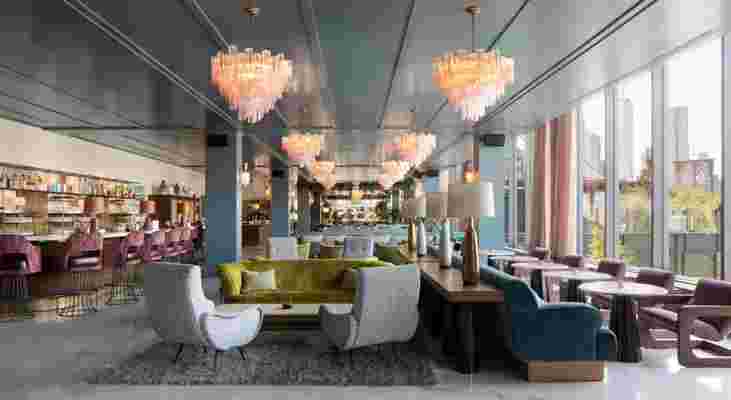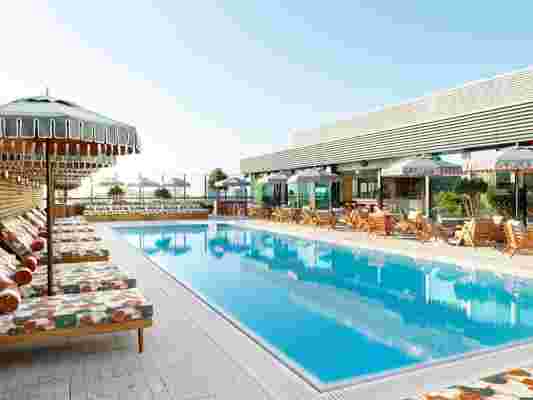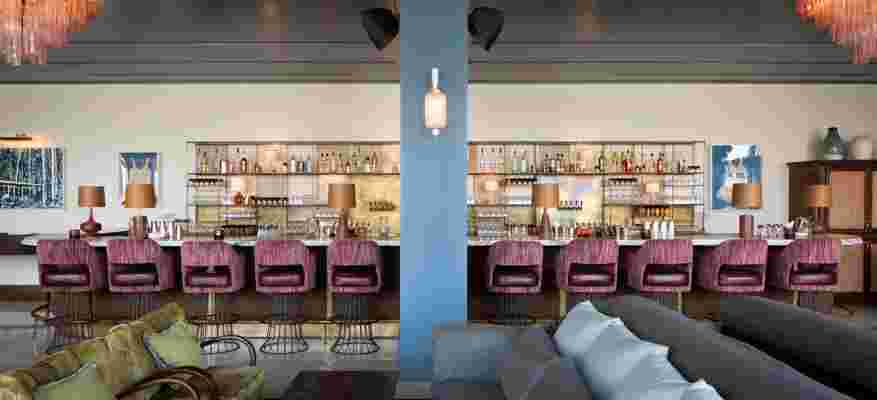Nick Jones (Soho House’s CEO and founder) is seated at Soho House’s new club, DUMBO House. He admires the vista—which extends from the Brooklyn Bridge to the Manhattan Bridge. Here, on the East River, there’s a sense of scale. “I’m a sucker for a good view,” he intimates. “We love a good view if we can get one.”
This month, Soho House has introduced two destinations—both with roof-deck pools: DUMBO House (at 55 Water Street in Brooklyn, New York) and White City House (at 101 Wood Lane in London). The brand, which has evolved since it was established in 1995, has come to include 20 clubs. “I think people use our clubs in different ways than they did 20 years ago,” shares Jones. “The young kids are more entrepreneurial. They don’t want corporate life, and I think that plays into our hands. We have a huge amount of ‘Under 27’ members and it keeps growing.”

DUMBO House’s interiors were decorated to echo the artist studios that have been in the area since the 1960s and 1970s.
DUMBO House is the brand’s first club in Brooklyn—but the brand’s third club in New York. Its art is architecture-themed with a collection that includes contributions from David Adjaye, Zoe Buckman, and Steven Siegel. Its exterior and interior decoration is reminiscent of the 1960s–1970s (when the area became an enclave for artists and their studios) with “Manhattan Bridge Blue” walls that are the exact color as the Manhattan Bridge. “I always try to take something from the outside and bring it inside so that there's a continuation,” describes Jones. “We wanted it to be contemporary but, at the same time, incredibly comfortable. I think contemporary sometimes leads to discomfort. I think it's still got a very clubby, lush feel about it, but in a modern way.”

White City House’s tenth-floor deck area is dressed with 1960s-themed chaises and umbrellas and Terrazzo-tile floors.
White City House has been installed in West London’s Television Centre. Architect Graham Dawbarn’s iconic construction, which encircles a statue of Helios, was BBC’s home from 1960 to 2013. In the three-floor club area as well as in the 45 bedrooms, there’s a 1950s vibe with accents that include oakwood walls and terrazzo-tile floors. There are, also, references to the BBC—including a front desk that resembles a TV studio and House Canteen restaurant’s “Dear Tony Hart” art installation (which is dedicated to the BBC’s famous illustrator). “What we tried to do was pay homage to the fact that it was built in the late 1950s without being retro and without trying to be too quiche about it,” describes Jones. “And there’s a lot of TV stuff.”
Hey, it’s summer. And this is where those who are suckers for a good view—or suckers for a good view and roof-deck pools—will be.
DUMBO House:

On the walls, there are works from artists David Adjaye, Zoe Buckman, and Steven Siegel.
The “Manhattan Bridge Blue” walls are the exact color of the Manhattan Bridge (which is seen through the windows).
The restaurant—which serves new American cuisine—features a kitchen with a wood-fired oven.
The terrace boasts extensive Manhattan views that stretch between the Brooklyn Bridge and the Manhattan Bridge.
White City House:
The main restaurant at White City House, House Canteen, features the “Dear Tony Hart” art installation (which is dedicated to the BBC’s iconic illustrator). It features art commissions from Mat Collishaw, Gavin Turk, and Mark Wallinger, among others.
The 45 bedrooms are decorated around a 1950s theme (e.g., George Nelson lamps, midcentury furniture, etc.) with scattered references to the BBC.
An architectural, spiral-shaped staircase connects the club’s three floors.
This art installation is a nod to the BBC’s children’s show, Playhouse (1964–1988).
RELATED: Get a Sneak Peek Inside Kettner’s Townhouse in London
